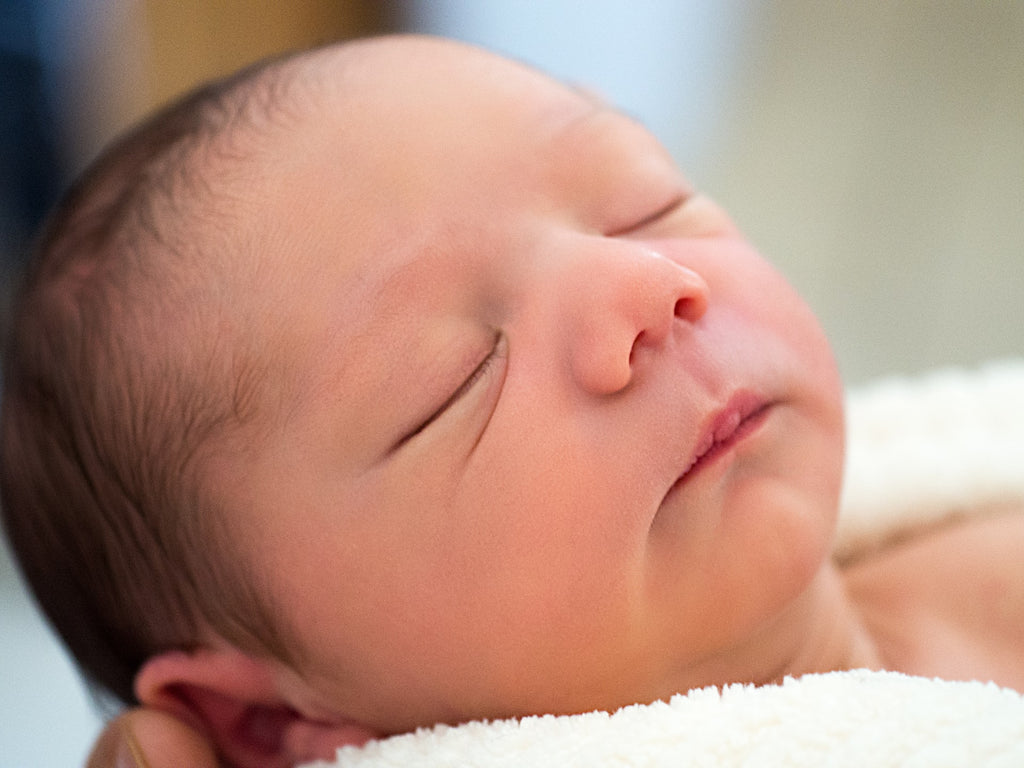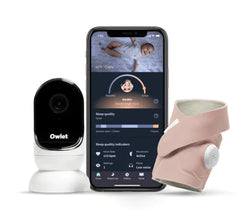If there’s one thing all new parents wish for their babies, it’s safe sleep. Sudden Infant Death Syndrome (SIDS) is a threat many parents and caregivers worry about, but there are lots of things you can do to make sure your baby sleeps as safely as possible. We understand that reading about SIDS is scary, but remember that it’s rare and the risk to your baby is low.
As we move into October, and Safe Sleep And SIDS Awareness Month, we’re here to give you the support you need to significantly reduce the risks. Here’s PishPosh Baby’s Safe Sleep Guide For Babies.
Why Is There Safe Sleep And SIDS Awareness Month?
October is Safe Sleep and Sudden Infant Death Syndrome (SIDS) Awareness Month. It’s part of the National Institute of Child Health and Human Development’s larger Safe to Sleep campaign. Launched in 1994, the campaign encourages parents, caregivers and service/healthcare providers to practice safe infant sleep and help raise awareness about ways to reduce the risk of SIDS.
This is because, despite decreases in rates of SIDS and other sleep-related infant deaths, more than one-third of sudden unexpected infant deaths that occur in the United States each year are from SIDS.
What Is SIDS?
Sudden infant death syndrome (SIDS) is the sudden, unexpected and unexplained death of an apparently healthy baby. This usually happens in their sleep. Unfortunately, we don’t know what causes SIDS. It is thought that a combination of factors affects babies aged under 12 months at a vulnerable stage of their development, which causes them to die suddenly and unexpectedly.
Why Should I Put My Baby Down On Their Back?
The American Academy of Pediatrics has advised putting babies to bed on their backs as a precaution against SIDS for more than a decade, after years of recommending that they sleep on their fronts. The change came in 1992, after reviewing British and Australian research on SIDS, which suggested that parents put babies to bed on their backs in their first year.
At that time in the United States, 70% of infants slept on their stomachs. By 2002, it had dropped to 11.3%. During that period, SIDS deaths were cut by half. Clearly, there is some connection between stomach-sleeping and SIDS, but doctors still don’t know what it is.

Always place your baby on their back to sleep and not on their front or side for every sleep, day and night. This is one of the most preventative actions you can take to ensure your baby sleeps as safely as possible. It can reduce the risk of SIDS by six times compared with them sleeping on their stomachs.
What If My Baby Doesn’t Like Sleeping On Their Back?
Try to encourage your baby to sleep on their back from day one. Put them down on their back when they’re awake or if they’ve fallen asleep in your arms. As they develop, and have learned to roll onto their tummy, they will be able to find their own sleeping position. Once they’re able to hold up their head by themselves, encourage lots of supervised tummy time during the day to support their development.
Some parents worry that a baby sleeping on their back will be at a greater risk of choking on their own vomit. There is no research that shows this is the case and, by sharing a room with your baby, you’ll be able to immediately tend to your little one.
Should I Share A Room With My Baby?
Yes! Sharing a room with your baby for at least the first six months can halve the risk of SIDS. Give them their own safe, clear space near your bed so you can easily get up and tend to them at night. We like the dadada Soho 3-In-1 Convertible Crib, which has been tested and scientifically proven to have low chemical emissions. A cradle or bassinet can be easily moved into whichever room you’re in for nap times, so you can put them down to sleep but remain with them while they snooze. The BabyBjorn Cradle, for example, has transparent mesh fabric so you can easily supervise your baby.
After your baby has reached six months, if you do leave them in another room, have more peace of mind with a monitor. The Owlet Dream Duo allows you to see and hear your baby from anywhere and view your baby’s sleep quality indicators in the moment, including wakings, heart rate and movement.
How Do I Make My Baby’s Sleeping Spot Safe?
Whether you choose a crib, cot or bassinet, the American Academy of Pediatrics recommends choosing a product that ‘adheres to the June 2021 Consumer Product Safety Commission’s rule that any infant sleep product must meet existing federal safety standards for cribs, bassinets, play yards and bedside sleepers’. The guidance also advises that parents should not use products for sleep that aren’t specifically marketed for sleep, such as car seats, bouncers, strollers, swings, carriers or slings. The new federal Safe Sleep for Babies Act will help get rid of potentially dangerous baby sleep products such as inclined sleepers, in-bed sleepers, loungers, and travel/compact sleepers by mid-2022.
Here are some top tips to check off:
- Use a flat, firm mattress with a fitted sheet.
- Make sure your mattress is designed for your specific crib, cot or bassinet.
- No pillows, bumpers, blankets, quilts, duvets, sleep positioners, pods or soft toys.
- Keep your baby’s head uncovered so they don’t overheat.
- Ensure nothing is within reach, such as blind cords.
- Pack away floaty items, like diaper bags.
- Place your baby at the bottom of the cot so they can’t wriggle under the covers.
- Swaddle them if they like it and they’ve not started rolling over.
- Use an age- and temperature-appropriate sleep sack.
- If they fall asleep in a car seat, remove them as soon as possible to a firm sleep surface.
How Warm Or Cool Should My Baby Be When Sleeping?
Babies under six months old cannot easily regulate their body temperature. An overly warm room or too many layers of clothing can cause them to overheat, which increases their risk of SIDS. Keep them consistently cool and comfortable while they sleep by:
- Staying close so you can monitor their temperature. Buy an indoor thermometer so you can better control the temperature.
- As a general rule, above 72 degrees Fahrenheit, or 22 degrees Celsius, may be too warm. Do take into account the typical climate in your region and use a fan or air conditioning as needed.
- Place the crib away from windows and radiators.
- Dry climates may benefit from a humidifier, which adds much-needed moisture to the air and creates optimal breathing conditions. Try the Crane Drop Cool Mist Humidifier, which works by using high-frequency vibrations into a very fine mist and sending it into the air without heating the air.
For handy tips about safe sleep in hot weather, follow these ways to help your baby to sleep better in summer.
What Should My Baby Wear At Night or Naptime?
Choose temperature-appropriate, well-fitted sleepwear. Newborns and babies under six months may need an extra layer, but don’t pile them on or they may risk overheating. Keep their face and head uncovered as this aids heat regulation. Sleep sacks are considered to be safer than blankets as they keep their heads and faces free – choose one that can keep them cozy in colder climates or during winter, and comfortably cool in summer or warmer locations. If your newborn loves to be swaddled, use a light fabric.

How Does Smoking Affect My Baby’s Safe Sleep?
Babies who are exposed to cigarette smoke before and after birth are at an increased risk of SIDS. This is because smoke inhalation makes babies more susceptible to viral and bacterial infections. Do not let anyone smoke around your baby or anywhere in the house, including visitors. Ask them to go outside. If you smoke, ensure your house is a smoke-free zone and go outside to smoke – take your baby in a stroller and keep a safe distance. Avoid smoky places and never expose your baby to smoke in the car.
What About Co-Sleeping – Should I Share A Bed With My Baby?
Official evidence-based American Academy of Pediatrics (AAP) guidance strongly recommends that you should never share a bed with your baby. This is a highly emotive subject, however, as families have been co-sleeping or bed sharing for millenia. For some parents, it is about bonding with their baby, and ease of breastfeeding; for others, exhausted parents just happen to fall asleep with the baby in their bed. Advice to discourage bedsharing can also mean that tired parents end up feeding their baby on a sofa, which recent AAP guidance agrees is much more risky than co-sleeping in bed.

Whether you choose to co-sleep or it just happens, here are some ways to keep it safe.
- Ensure you or anyone in the bed don’t doesn’t smoke, hasn’t recently consumed alcohol or taken any drugs that make you feel sleepy.
- Keep pets and any other children away from the bed.
- Keep adult bedding and pillows away from your baby.
- Use only lightweight blankets.
- Sleep in a bed with a firm mattress that fits tight against the bed frame.
- Remove headboards and footboards.
- Push the bed away from the wall and bed stands.
- Make sure the bed is far from curtains, blinds, draperies and cords.
- Never put your baby on a water bed.
- Never sleep with your baby on a sofa or armchair.



